South Russian Shepherd Dog: breed standards and content
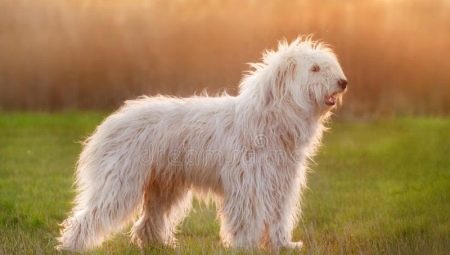
The South Russian Shepherd Dog is a traditional shepherd dog breed with excellent watchdog qualities. Its large size and abundant wool make it an excellent option for outdoor or enclosure keeping, carrying out a protective guard service. Throughout its existence, the breed has been on the verge of extinction more than once. But in the 21st century, its popularity has increased again, and today many dog breeders are thinking about buying such a pet. Why is the South Russian Shepherd Dog so attractive, and what difficulties may arise with its maintenance?
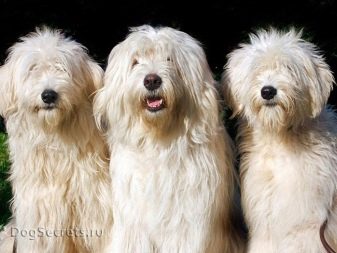
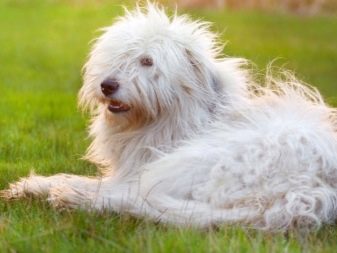
History of appearance
In Russia, there are not so many local breeds of exclusively domestic breeding. One of the main achievements of breeders is rightfully considered the South Russian Shepherd Dog, which got its name from the territory of distribution of these animals. Even during the reign of Empress Catherine II, the south of Russia was the main agricultural region of the country. At the end of the 18th century, attempts were made to introduce sheep breeding on the territory of Tavria, and cattle were imported from abroad.
To protect the most valuable merino sheep, dogs from Spain came to the country and were used in their homeland for this purpose. But the well-proven Asturian Shepherd Dog was not too large and was not very effective when faced with aggressive steppe wolves. Local breeders were faced with the task of developing a hybrid with good herding skills and sufficient physical strength to prevent any attacks.
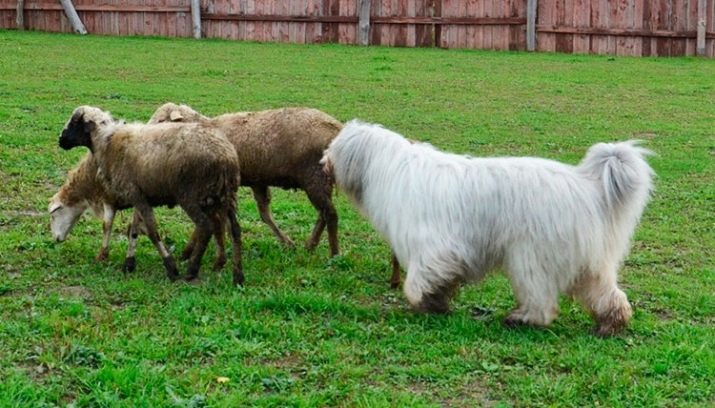
In the Kherson estate of Askania-Nova, the famous dog handler and enthusiast of his time, Baron Falz-Fein, took up breeding work. Asturian Shepherd Dogs, Polish Tatra Shepherd Dogs and Russian Greyhound Dogs were used as a starting material in the crossing. As a result of careful selection of blood, it was possible to obtain dogs with a well-developed hunting instinct, tireless in running, tall at the withers, aggressive and hardy. The South Russian Shepherd Dog inherited the snow-white color of its coat from its Tatran ancestor.
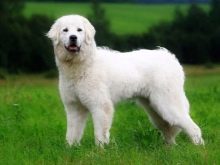

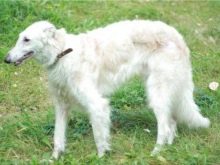
During the First and Second World War, the breed managed to demonstrate its best qualities. Her performance in the protective guard service is not much inferior to German shepherds. Dogs were successfully used in various branches of the armed forces, but selection work and breeding almost completely fell into decay. By the middle of the 20th century, with the decline in the popularity of sheep breeding, the need for its unique qualities almost disappeared. For many years, the South Russian Shepherd Dogs have been very exotic guests at exhibitions.
Everything has changed on the eve of the XXI century. The herding breed was again appreciated and actively bred. Unfortunately, the small volumes of available breeding material led to the fact that the South Russian Shepherd Dog had a significant admixture of the blood of a Caucasian fellow. It was also not possible to restore the original appearance in full - the breed standard was changed taking into account the current phenotype.
It is worth noting that the definition "South Russian Shepherd Dog" in relation to a specific group was used by the famous dog handler L. P. Sabaneev. The first official standard was adopted in 1931. And the FCI recognized the breed only in 1996, from that moment the modern history of the South Russian Shepherd Dogs began.
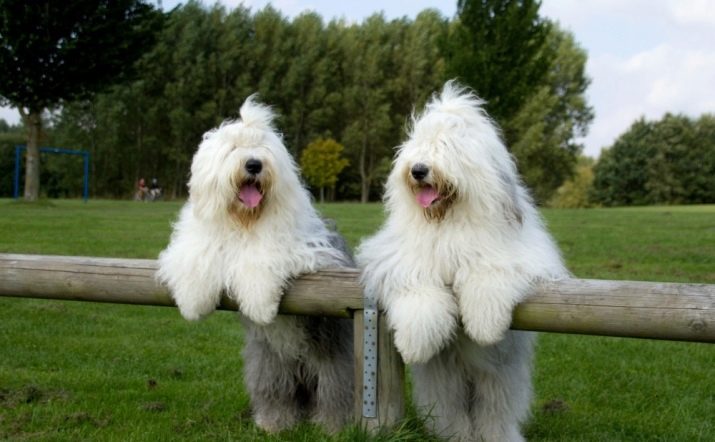
Description of the breed
A large and strong service dog - the South Russian Shepherd Dog - looks very impressive. The description of the breed and the standards of puppies allow them to be rejected even at the stage of evaluation by the breeder. Rigorous selection minimizes the risks of breeding marriage. Modern standards differ significantly from those that were in effect for dogs of the South Russian breed initially.
So, black, red, brown colors are considered unacceptable, also excluded:
- "Mask" on the face;
- white or blue eyes, heterochromia;
- deafness;
- scanty (shortened) tail;
- hair that is too short, soft or prone to cords;
- square body format;
- body imbalances;
- behavioral vices - cowardice or unmotivated aggressiveness.
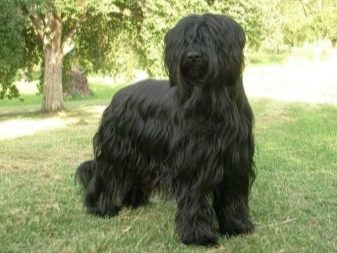
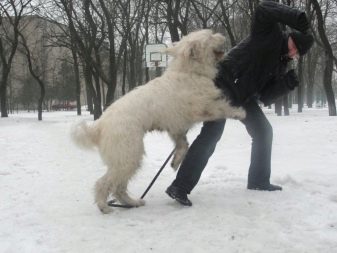
Visually, the South Russian Shepherd Dog on the pasture can be easily confused with the representatives of the herd she protects - in the conditions of cattle grazing, this valuable quality gave the desired camouflage to the guarding animal. A large dog with a lush, coarse coat looks very impressive. But this does not change the requirements for the compliance of the animal with the established exterior parameters.
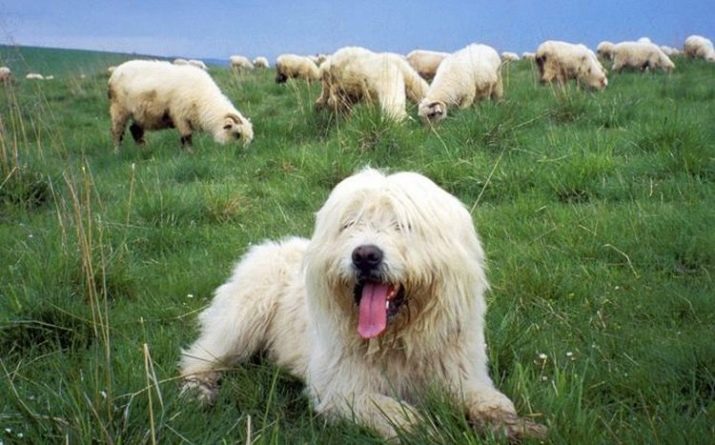
The South Russian Shepherd Dog must have the following characteristics.
- Color. For the undercoat, only light color, high hair softness is allowed. The awn can be pure white or light fawn, yellowish, or gray-tan.
- Wool cover. Should be dense, hard, with slight waviness in length. The vegetation is homogeneous throughout the body. The standard length is at least 10 cm, including on the head and neck.
- Body type. Initially, dogs are distinguished by strong bones without excessive dampness. The body is dry and taut. The modern version of the breed is more massive and muscular.
- Body weight not less than 35 kg. The growth of the animal at the withers is 62–66 cm, males are taller and larger than females.
- The belly is tucked deep and high, like a greyhound. The rib cage is wide and deep, well defined.
- The head is wedge-shaped, with an elongation of the muzzle, the feet are smoothed. The ears are high-set, triangular in shape, hang down on the sides of the head, completely covered with hair.
- Nose with bright black pigmentation of the lobes, well defined.It has a characteristic taper towards the end of the muzzle.
- Wide-set, compact, oval-shaped eyes, all brown colors acceptable.
- Jaws closed in a scissor bite, strong, teeth with white enamel color, large.
- The neck is of medium length, straight, without dewlap.
- The tail is straight, drooping towards the hock, with a slight bend at the end.
- The limbs are long, strong, with sweeping movements.
The sex difference in the South Russian Shepherd Dogs is pronounced. Males have a more massive body, always higher at the withers, have a more compact proportional body.
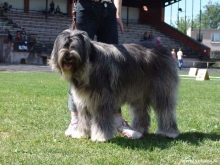
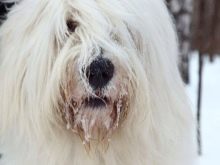
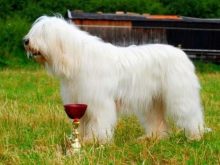
Character and behavior
The South Russian Shepherd Dog is not a pet, but a serious guard dog, bred to guard sheep flocks. High intelligence, the ability to independently make decisions, the ability to take initiative at the right time - these are the distinctive features of this breed. The South Russian Shepherd Dog is not characterized by excessive phlegm or apathy, as well as excessive submissiveness. From their ancestors, they received the hunter's instinct and excellent sense of smell.
The South Russian Shepherd Dog is suitable for training in protective guard service, but is prone to independent application of the acquired skills. Instead of one tight grip and fixation of the victim, the dog makes several attacks, which do not give the offender an opportunity to escape. It is quite difficult to resist such an onslaught, since the behavior of the animal does not fit into the framework of standard schemes.
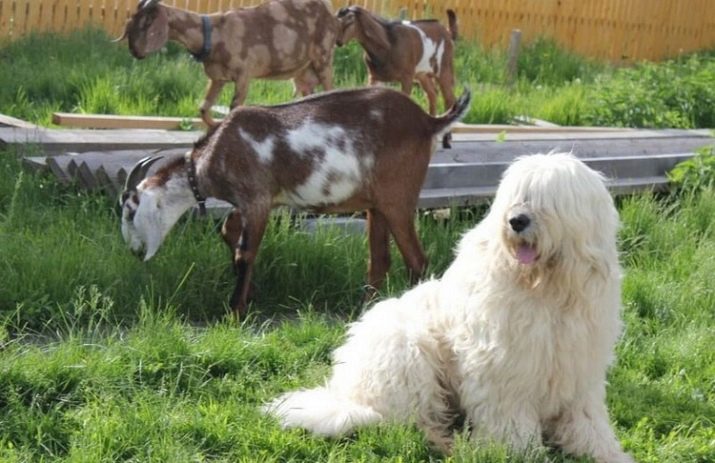
YURO is a breed with a developed sense of territorial belonging. The house, which she considers her own, the dog will guard until the last breath. But she is difficult to adapt to the move and almost always recognizes only one owner. The best solution for her would be a family country house or a large farm that allows her to frolic properly. The breed is emphatically distrustful of strangers, and with persistent attempts to communicate, it can show anger. If the boundaries of the territory are violated, the dog does not burst into warning barking, but silently attacks.
It is very important to remember that the South Russian Shepherd Dog has a pronounced tendency to dominate and is not suitable for owners with little experience in animal training. YURO does not get along with children, and it is better to prevent any contact of the dog with overly active and obsessive babies.
The dog will not make discounts for age and height indicators. If it seems to him that the boundaries are violated, he can attack. But with the right approach to business, the South Russian Shepherd Dogs lend themselves well to training and turn out to be ideal partners in the work of law enforcement agencies or security activities.
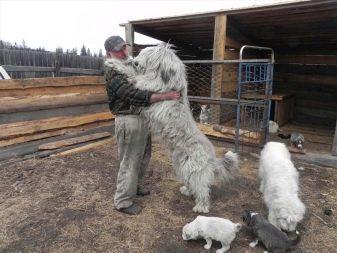
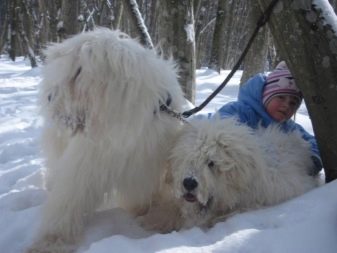
Maintenance and care
Despite the excellent guarding qualities of dogs and their general unpretentiousness, caring for the South Russian Shepherd Dog requires some attention. The animal's undercoat is so thick that without regular combing it quickly falls into a kind of felt. For constant maintenance, you need a long-toothed comb. In addition, you need to monitor the characteristics of the coat in order to notice health problems in the dog in time.
Dullness, increased sebum production, and a sloppy look are signs of a possible illness or metabolic disorder.
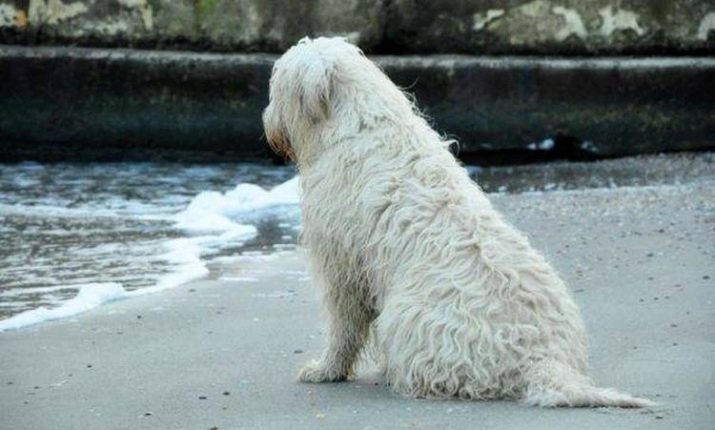
The South Russian Shepherd Dog needs grooming. There are various haircut options:
- exhibition - to bring the animal in line with breed standards;
- with a "skirt" - an elongated coat on the sides and hind legs, the front part of the body is cut short;
- with "trousers" - in this case, long stripes remain only on the limbs;
- under the "puppy", with shortening of hairs throughout the body to a length of 3-5 cm from the root.
The animal's muzzle is processed separately. Here, a continuous shortening is used up to 1–2 cm from the root, possibly with the design of an elongated bangs reaching the eyes. In addition, there is a spaniel haircut. In this case, the hair on the surface of the ears is also shortened.The need for professional grooming is especially high during the molt of the animal - in this case, the dog is recommended to intensive combing, removing most of the undercoat.
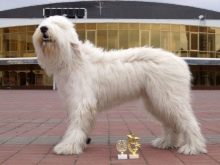
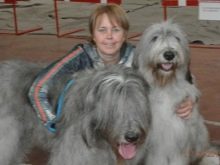
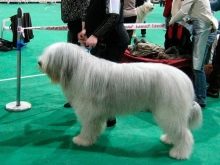
Bathing of the South Russian Shepherd Dog should be carried out at least 1 time per season; in the summer, an additional intake of water procedures is allowed.
Ear cleaning, antiparasitic treatment should be carried out regularly. Dogs' nails that do not grind naturally are trimmed. You need to teach a pet to the procedure as a puppy, then there will be no problems with an adult animal either.
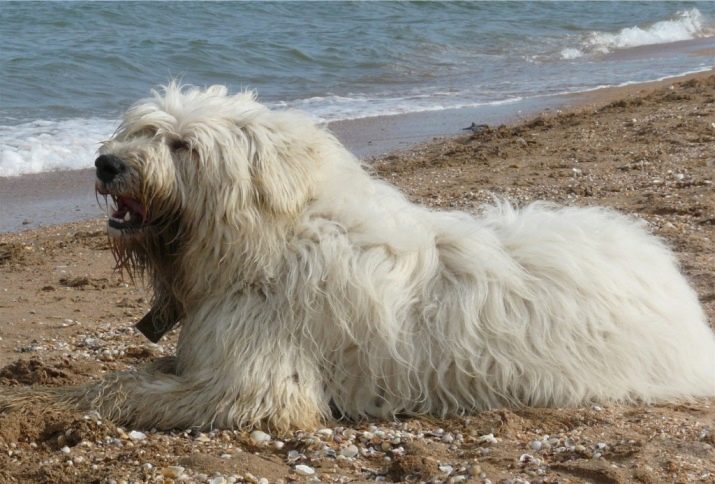
Features of the content
For the South Russian Shepherd Dog to feel good, it needs a fairly high level of physical activity. Simple running or jumping is not enough for an animal. To properly tire the dog, you will need cycling, and the place for its free movement in the yard should not be limited by the aviary or the length of the chain.
The breed is also not suitable for keeping all day in the four walls of a city apartment.
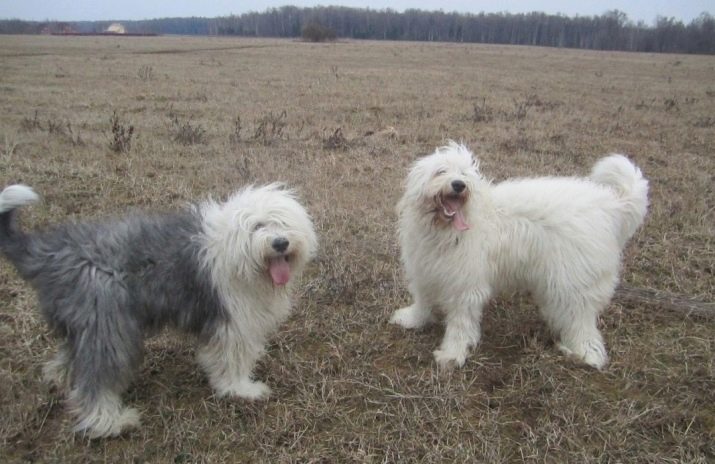
Good health makes it possible for the South Russian Shepherd Dog to live much longer than representatives of other large breeds. On average, a dog is able to remain active for 15-17 years. It is worth considering the significant load on the joints of the animal - to prevent their premature wear, special preparations, vitamin and mineral supplements are prescribed.
The South Russian Shepherd Dog is characterized by the need for reliable protection of the ears from hypothermia, water ingress. The structure of this part of the body is prone to the development of otitis media. Another urgent problem is the development of an allergic reaction to insect bites. The saliva of the blood-sucking parasites causes severe itching, swelling and other unpleasant symptoms. Protection against attacks by fleas and ticks should be given special attention.
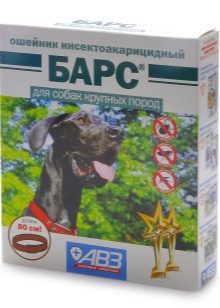

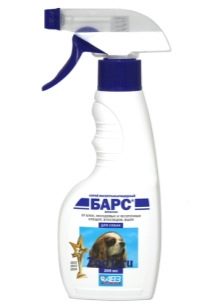
Feeding
The South Russian Shepherd Dog belongs to large dog breeds, puppies of which show very fast growth. The optimal solution in this case may be a specialized feed designed for the giant category.
The standard food requirement of an animal is 30 g of dry and 50 ml of liquid food per 1 kg of pet's body weight. With increased physical activity, these norms increase.
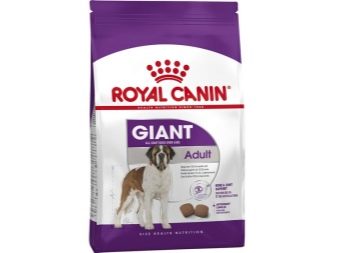
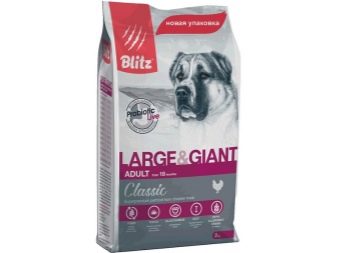
There are also special requirements for the drinking regime. An adult dog of the YURO breed needs from 1 to 3 liters of clean water, it should be changed in a bowl daily. Feeding is done twice a day. As a delicacy, you can offer large bones with meat and cartilage remains.
It is recommended to add sea fish, boiled vegetables, low-fat cottage cheese to the puppies' nutrition., porridge with the addition of chopped meat in a strong broth. Up to six months, the number of feedings reaches 5-6 times, then by the year their number is gradually reduced.
When selecting ready-made feeds, preference is given to super-premium products.
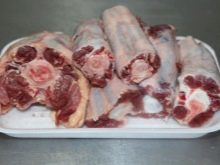
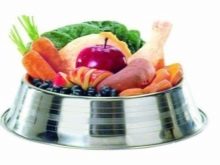
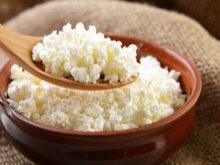
Education and training
South Russian Shepherd Dogs are intelligent dogs, and with the right approach they master the basics of the general training course well. A good memory allows them to learn a lot of commands and act on their own. Thanks to her keen sense of smell, she can be trained in tracking and search activities. But the wayward character of the dog requires an individual approach to the training process. Due to the fact that YURO is distinguished by excellent intelligence, its study begins at a puppy age. It was during this period that the animal's desire for domination, a sense of territoriality, and the instincts of a hunter began to appear.
If the pet is already beginning to show signs of aggression, this may mean that time is lost and behavior correction will be required.
Since the South Russian Shepherd Dogs have a lively, choleric temperament, first of all, they are recommended to master commands that mean prohibitions. Classes should be conducted in the form of a game, gradually achieving complete obedience. In adolescence, the breed often demonstrates a violent disposition - you can not leave commands without execution.The animal must know that the owner's order will have to be carried out in any case.
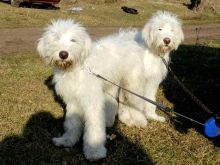
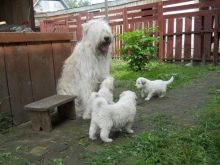
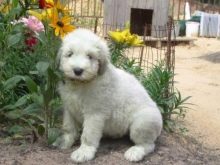
The independent character was brought up in the South Russian Shepherd Dogs for centuries, because in the pasture conditions the dog had to remain without the control of the owner for a long time. In keeping with other animals, the pet occupies the top position in the hierarchy and insists on its own, even in those cases when it meets resistance.
The breed is categorically not suitable for the elderly, as well as for children and adolescents. The puppy's youthful charm passes quickly enough, and an adult animal requires very strict treatment with itself. At least once giving slack or showing aggression, the owner can lose the trust and respect of the dog.
The training process will take several hours a day. If there is not enough time, it is better to abandon the idea of educating YURO.
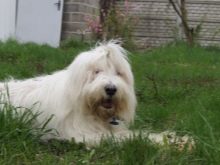
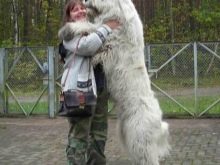
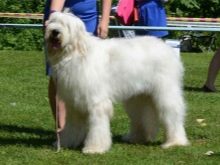
You will learn even more interesting facts about the South Russian Shepherd Dogs from the following video.






































